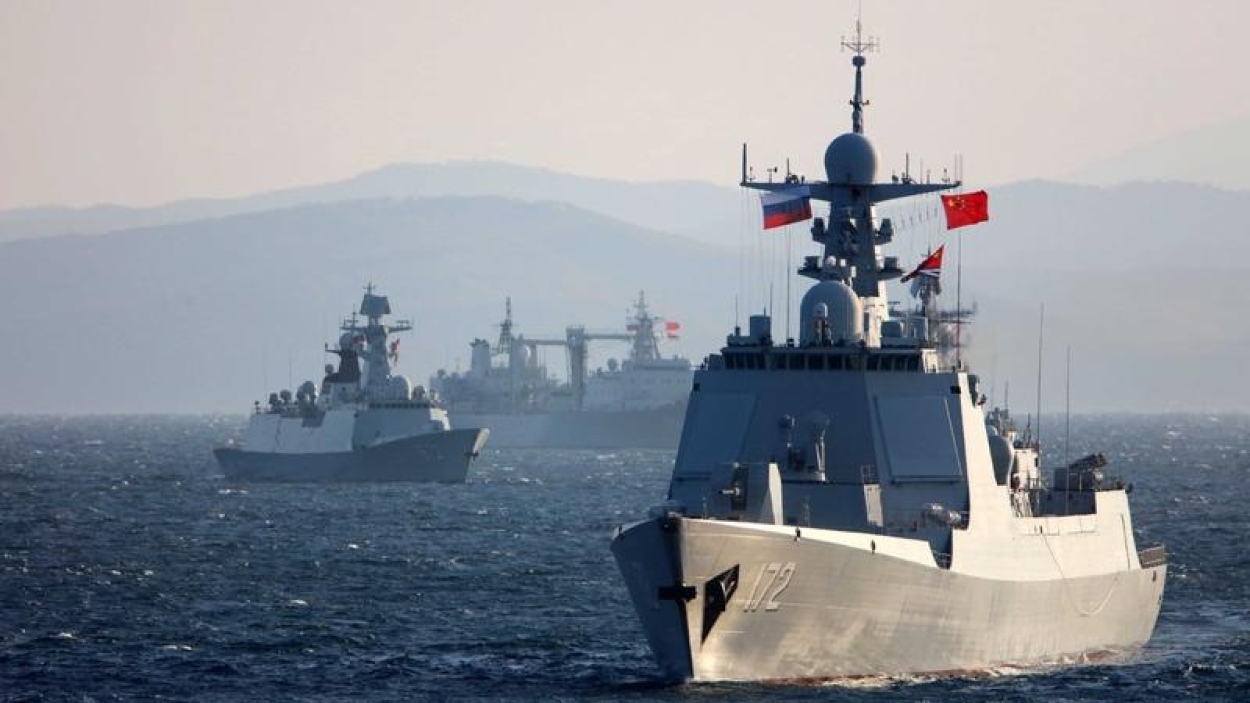Chinese Warships ‘Pop-Up’ Near U.S. After Russian Nuke Sub; Freedom Of Navigation Or Message To NATO?

The Arctic and northern Pacific have emerged as pivotal areas in the ongoing power struggle among global giants—China, Russia, and the United States. Along with the South China Sea, they are a freezing-cold hotspot in the global geopolitics.
Earlier this month, the United States Coast Guard reported an encounter involving several Chinese military ships and US Coast Guard vessels in the Bering Sea near Alaska.
The US Coast Guard Cutter Kimball – a NATO warship operating under the United States flag, discovered three Chinese vessels approximately 124 miles (200 km) north of Amchitka Pass in the Aleutian Islands, situated between Alaska and Russia in the Northern Pacific Ocean.
Concurrently, a US Coast Guard Air Station Kodiak aircrew identified a fourth Chinese vessel about 84 miles (135 km) north of Amukta Pass.
In a statement, the United States Coast Guard downplayed the incident and said that all four Chinese ships were transiting international waters “in accordance with international rules and norms” but were within the US exclusive economic zone (EEZ), which extends 200 nautical miles (370 km) from the US coast.
The US had also downplayed the incident when the Russian nuclear submarine Kazan and other warships had docked a mere 90 miles off Florida.
AfriPrime App link: FREE to download...
https://www.amazon.com/Africircle-AfriPrime/dp/B0D2M3F2JT
Exclusive Economic Zone (EEZ)
The concept of an exclusive economic zone (EEZ) was established through the 1982 United Nations Convention on the Law of the Sea (UNCLOS). This convention allows countries to claim EEZs, granting them sovereign rights over maritime resources beyond their 12-nautical-mile territorial sea.
The difference between a territorial sea and an EEZ is that the former confers full sovereignty over the waters, while the latter grants “sovereign rights” to the coastal state over the resources beneath the sea’s surface. The surface waters of an EEZ are considered international waters.
An EEZ generally extends 200 nautical miles (230 miles) beyond a nation’s territorial sea. Within this zone, a coastal nation has jurisdiction over both living and non-living resources.
The United States claimed its 200-nautical-mile EEZ in 1983, encompassing areas like Puerto Rico, Guam, American Samoa, the U.S. Virgin Islands, the Northern Mariana Islands, and other U.S. territories. With more than 3.4 million square nautical miles (4 million square miles) of ocean, the U.S. EEZ is larger than the land area of all 50 states combined and is one of the largest EEZs in the world.
The exact boundaries of EEZs are often sources of conflict between states, as seen in the South China Sea. Additionally, regions where permanent ice shelves extend beyond coastlines can also become areas of potential dispute.
China’s Strategic Move In The Arctic
The presence of Chinese naval vessels near US waters marks a strategic move, contrasting with frequent US naval confrontations with China in the South China Sea and near Taiwan.
This maneuver aims to counter the strategic agenda led by Washington and NATO in the region, highlighting increased military cooperation between Beijing and Moscow in the Arctic and northern Pacific.
Despite China’s expanding naval capabilities, which now exceed the number of US naval ships albeit with smaller firepower, the incursion reflects China’s intent to assert itself in regions far from its shores.
China’s interest in the Arctic, including the waters near Alaska where this encounter occurred, aligns with its expansionist geopolitical strategy. The U.S. has raised concerns over China’s increasing presence and monitoring activities in the Arctic, questioning the underlying motives.
AfriPrime App link: FREE to download...
https://www.amazon.com/Africircle-AfriPrime/dp/B0D2M3F2JT
Freedom of Navigation Operations: A Two-Way Street
The U.S. Coast Guard reported that the Chinese vessels responded to radio communication, affirming their purpose as “freedom of navigation operations.”
The Coast Guard Cutter Kimball monitored the Chinese ships until they moved south of the Aleutian Islands into the North Pacific Ocean. The Kimball continues to monitor activities in the U.S. Exclusive Economic Zone to ensure the safety of U.S. vessels and international commerce in the area.
Liu Pengyu, a spokesperson for the Chinese Embassy in Washington, told Newsweek that the Chinese navy consistently exercises its navigation rights under international law and UNCLOS in a safe and professional manner.
It’s worth noting that the U.S. frequently conducts “freedom of navigation operations” in the South China Sea and transits the Taiwan Strait, challenging China’s territorial claims and often drawing Chinese ire.
China’s naval maneuvers off Alaska serve multiple purposes: signaling their expanding naval capability in the Pacific and closer to the Arctic, responding to U.S. policies in the South China Sea, and expressing concerns about international maritime laws potentially curtailing Chinese maritime power.

The China-Russia Arctic Alliance
The Arctic region has gained strategic importance due to its role as a vital maritime link between the Asia-Pacific and Europe, accentuated by the effects of climate change melting Arctic ice. Consequently, Alaska and the Bering Sea in the North Pacific Ocean have emerged as crucial gateways to the Arctic Sea.
Traditionally a point of contention between the U.S. and Russia, the Arctic is now witnessing China’s bid to assert itself as a dominant player in the region.
Recently, Russia invited China to collaborate on developing the Northern Sea Route (NSR) and establishing an ice-class merchant fleet.
The North Pacific Ocean is increasingly becoming a stage for enhanced Sino-Russian maritime cooperation. Beijing seeks to partner with Moscow to counter what it perceives as a U.S.- and NATO-led push to expand Western strategic interests in the far north. China aims to bolster its military presence in the Arctic by aligning strategically with Russia.
China’s self-positioning as a ‘near-Arctic state’ underscores its ambition to capitalize on economic opportunities, including the extraction of oil, gas, and minerals, as well as exploiting shorter maritime routes between Asia and Europe.
Collaborative efforts with Russia will further augment China’s military presence and surveillance capabilities in the Arctic, challenging U.S. influence and capabilities in the region.
Naval Encounters & Regional Dynamics
Tensions between China and the US have escalated recently over Taiwan, a self-ruling island Beijing claims as its own. Similar tensions persist in the South China Sea, contested by multiple nations against China’s claims.
The sightings on July 6 and 7 came a week after the Chinese navy started a joint patrol with its Russian counterpart in the Pacific Ocean. This is the latest in a series of annual patrols that began in 2021.
This marks the fourth consecutive year of Chinese military presence in the region. In 2021 and 2022, there were also documented encounters with Chinese vessels in the Bering Sea. In September 2022, Russian and Chinese warships were observed several dozen miles off an Alaskan island.
In 2023, US Navy warships were dispatched to the Aleutians after 11 Chinese and Russian military vessels were identified operating in the region. According to US Coast Guard spokesman Lt. Cmdr. Michael Salerno, encounters with Chinese vessels in the Bering Sea have occurred annually since 2021, with Chinese naval ships first noted in the area in 2017.
More recently, Russian warships and a nuclear-powered submarine were reported near the US, with a Russian warship observed near Florida’s coast in June 2024 en route to joint naval exercises in Havana Bay, causing concern in the US and Canada.
A Canadian patrol ship also visited Havana Harbor. Meanwhile, the US fast attack submarine Helena docked at Guantanamo Bay, a US naval base located 850 km southeast of Havana.
Strategic Implications
China’s military partnership with Russia enhances Moscow’s capability to wield hard power in the Arctic, presenting a challenge to NATO states in the region. This collaboration is pivotal in enabling Moscow to maintain its hard power influence over NATO members in Arctic areas.
In the broader context, the recent Chinese naval presence near Alaska is just the tip of the iceberg. It’s a visible manifestation of deeper geopolitical currents reshaping the Arctic landscape.
AfriPrime App link: FREE to download...
- Questions and Answers
- Opinion
- Story/Motivational/Inspiring
- Technology
- Art
- Causes
- Crafts
- Dance
- Drinks
- Film/Movie
- Fitness
- Food
- Jogos
- Gardening
- Health
- Início
- Literature
- Music
- Networking
- Outro
- Party
- Religion
- Shopping
- Sports
- Theater
- Wellness
- News
- Culture
- War machines and policy

